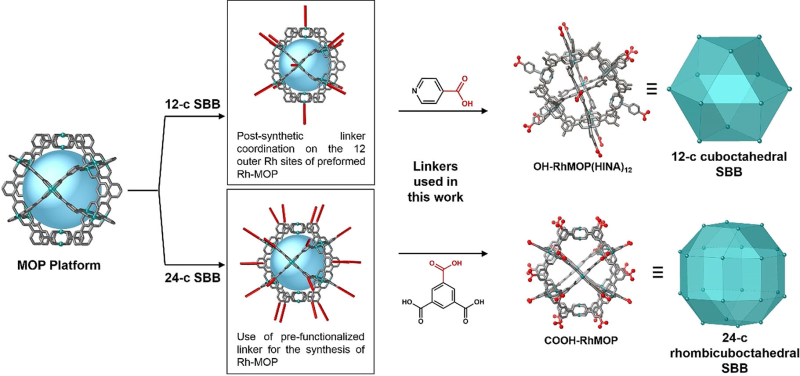Thursday, 11 February 2021
A new synthesis procedure involving metal-organic polyhedra for building MOFs
A study recently published in the journal Angewandte Chemie of the German Chemical Society, led by La Caixa Junior Leader Dr. Arnau Carné-Sánchez and ICREA Professor and ICN2 group leader Prof. Daniel Maspoch, explores the use of metal-organic polyhedra (MOPs) as building blocks to produce highly-connected metal-organic frameworks (MOFs). Pre-synthesized, isolated MOPs based on polycarboxylate cuboctahedral rhodium(II) were successfully applied to build MOFs, providing an alternative approach to their synthesis.

Metal-organic polyhedra (MOPs) are self-assembled supermolecules exhibiting interesting structures and functionalities. They can be applied as supermolecular building blocks (SBBs) to synthetize metal-organic frameworks (MOFs), a class of porous materials with useful properties. The use of preformed MOPs for this synthesis, though, remains scarcely investigated.
A study conducted by members of the ICN2 Supramolecular NanoChemistry and Materials group, led by ICREA Prof. Daniel Maspoch, in collaboration with researchers from the ALBA Synchroton (Barcelona), the Tarbiat Modares University of Tehran (Iran), and the Materials Science Institute of Madrid (CSIC), has explored the pre-synthesis of two types of MOPs based on polycarboxylate and their applications as building blocks for highly-connected MOFs. This work has been reported in a paper recently published in Angewandte Chemie, a journal of the German Chemical Society.
MOPs are investigated primarily for their intrinsic porosity, high symmetry and connectivity, characteristics that enable their exploitation for the synthesis of porous amorphous soft materials and to build connected nets of MOFs, following the SBB approach. In the here-highlighted paper, a different route to fabricate MOFs is explored: using pre-synthesised, isolated MOPs as SBBs.
The authors used cuboctahedral rhodium(II)-based MOPs, because of their high stability, symmetry, and easy functionalization. Two different cuboctahedral MOPs were synthetized: one was functionalised with twelve carboxylic acid groups, while the other with twenty-four carboxylic acid groups (these compounds are referred to as OH-RhMOP(HINA)12 and COOH - RhMOP).
The application of these preformed, isolated MOPs as SBBs for highly connected nets of MOFs was then demonstrated. To do so, the researchers made the polycarboxylate MOPs react with Cu(II)-based secondary building units (SBUs). These SBUs consist in two or three copper ions interconnected between them with organic constituents. They were able to connect the MOPs via these units, creating structured MOFs built up from both rhodium and copper ions. A key feature of the final MOFs is the existence of cavities, or cages, in their structure, which were present in the initial MOPs as well. “The importance of this study is that for the first time we have synthetized MOFs using cavities in pre-existent MOPs,” explain Dr. Arnau Carné-Sánchez and Prof. Daniel Maspoch.
This work confirms the utility of metal-organic polyhedra to act as supermolecular building blocks to create MOFs, and provides a different approach to construct them, enriching the current repertoire of strategies.
Reference article:
Thais Grancha, Arnau Carné‐Sánchez, Farnoosh Zarekarizi, Laura Hernández‐López, Jorge Albalad, Akim Khobotov, Vincent Guillerm, Ali Morsali, Judith Juanhuix, Felipe Gándara, Inhar Imaz, and Daniel Maspoch, Synthesis of Polycarboxylate Rhodium(II) Metal–Organic Polyhedra (MOPs) and their use as Building Blocks for Highly Connected Metal–Organic Frameworks (MOFs). Angewandte Chemie, Int. Ed. 2021, 60. DOI: 10.1002/anie.202013839

